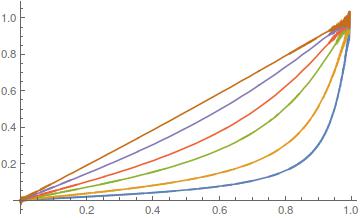If we have a massless cylindrical container (or radius $R$) with a liquid of certain density $\rho$ and viscosity $\mu$ at rest. Then at time zero we impart a constant rotational velocity $\Omega$ on the cylinder and watch as the liquid accelerates from the outer walls inwards (due to the viscosity).
I want to know what is the function of total angular momentum $L$ with time (and consequently the effective mass moment of inertia of the liquid $L=I_{eff} \Omega$). More specifically the radius of gyration $I_{eff} = m \kappa^2$ where $m=\rho \pi R^2 h$.
I looked at concentric cylindrical slices in order to derive the equations of motion but I am stumbling at the shape of the tangential velocity as a function of radius $r$ and time $t$.
Based on of $\nabla$ in cylindrical coordinates (for a Newtonian fluid) I think shear stress is $$\tau_{r\theta} = \mu \left( \frac{\partial v_\theta}{\partial r} - \frac{v_\theta}{r} \right)$$
The cylindrical slice has surface area $A = 2 \pi r h$, or ${\rm d}A = 2 \pi h {\rm d}r$.
The volume is ${\rm d}V = A {\rm d}r = 2 \pi r h {\rm d}r$.
I think the radial force balance acting on the volume due to the shear stress is $$ A {\rm d}\tau_{r\theta} + \tau_{r\theta} {\rm d}A = \dot{v_\theta} \rho {\rm d} V$$
In which this leads to a differential equation $$\tau_{r\theta}'= \frac{\partial \tau_{r\theta}}{\partial r} = \rho \dot{v_\theta} - \frac{\tau_{r\theta}}{r} $$
The shear stress slope is (from chain rule) $$ \tau_{r\theta}' = \mu \left( v''_{\theta} - \frac{v'_\theta}{r}+ \frac{v_\theta}{r^2} \right) $$
With some algebra I get finally that
$$\dot{v}_{ \theta} = \frac{\mu}{\rho} v''_{\theta} $$
So the acceleration of the cylindrical slice is proportional to the curvature of the velocity profile.
Here is where I am stuck. I am not sure how to proceed to derive $v_\theta (r,t)$.


